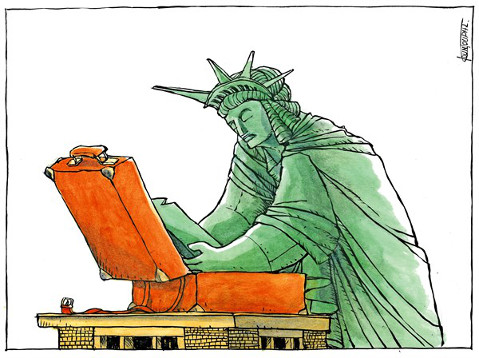The Divided States of America
Muslim Ban Challenges the Founding Values of Our Country

“Give me your tired, your poor, your huddled masses yearning to breathe free, the wretched refuse of your teeming shore. Send these, the homeless, tempest-tost to me, I lift my lamp beside the golden door!” This sonnet on the Statute of Liberty sums up one of the defining characteristics of America: a country of immigrants in the land of opportunity. It was this message of hope that early immigrations embraced when they entered America.
Today, the United States feels like the Divided States. With #MuslimBan trending after Trump’s executive order, protests erupted at airports across the United States and a federal court issued an order temporarily halting the executive order. As a Muslim, I can’t say I feel welcomed in the current political climate. As a permanent resident, despite living over 20 years in the United States and working for my country in public service, there is no guarantee that I wouldn’t be detained if I were coming in from an international flight. But with a name like Osaama, I suppose I should assume that.
Since President Trump’s election, there have been echoes throughout the country that his America’s isn’t the America we know. History is often the greatest reminder. If misogyny doesn’t exist in America, why is it only since the 1920s that women have been allowed to vote, and why has the country not yet had a female head of state? If racism in America has died, why are socio-economic classes stratified by race, and why did our first African-American president only get elected recently? If America has always been a land of immigrants, then why have exclusionary immigration policies always existed?
The latest executive order is only one of many exclusionary immigration policies that have plagued our nation. The Naturalization Act of 1870 was the first federal immigration law that denied entry of “undesirables” into the United States. And by “undesirables” that refers to anyone from Asia coming into America to be a contract worker. Seven years later, the Chinese Exclusion Act specifically denied entry and naturalization of people of Chinese descent for 10 years. It wasn’t until 1943, over 50 years later, that the United States repealed the Chinese Exclusion Act.
One common factor throughout these exclusionary immigration policies was the creation of illegal immigration. Quota systems were devised that allowed only a certain percentage to emigrate into the United States. In order to beat this, individuals would move to a country with a greater quota allowance and attempt to find a way into the United States. Regardless of the time we live in, people will always be moving. The manifest destiny that was so inherent to early Americans manifests in all people.
The implications of this executive order can be seen from the ripples of history. Like the Chinese Exclusion Act, if Trump’s exclusionary policies become actual laws, they could be much more permanent than temporary. In a world that has become more interconnected just in the last decade, such a policy could have devastating effects in building peace. The reality is that this executive plan is a blunt tool in attacking a specific issue — religious extremism. Blockading Muslim nations just because there have been “Muslim” extremists, would be like blockading southern states because there are “Christian” KKK members.
At the end of the day, the president and the United States determine who and who cannot enter America. But when that happens, we should remember the poor, huddled masses that yearn to breathe free and the hope represented by the Statue of Liberty.



